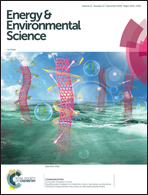Direct visible light activation of a surface cysteine-engineered [NiFe]-hydrogenase by silver nanoclusters†
Abstract
Genetically engineering a cysteine (thiolate) close to the distal [4Fe–4S] cluster of a [NiFe]-hydrogenase creates a highly specific target for attachment of Ag nanoclusters templated in polymethyl acrylate, the resulting ‘hard-wired’ enzyme catalysing rapid hydrogen evolution by visible light. The rate is further enhanced by binding to metal oxide nanoparticles – results of investigations focusing on P-25 TiO2 and including anatase TiO2, rutile TiO2, ZnO, SrTiO3 and ZrO2 leading to the proposal that these act as active or structural scaffolds to promote intra-assembly electron transfer.
![Graphical abstract: Direct visible light activation of a surface cysteine-engineered [NiFe]-hydrogenase by silver nanoclusters](/en/Image/Get?imageInfo.ImageType=GA&imageInfo.ImageIdentifier.ManuscriptID=C8EE02361A&imageInfo.ImageIdentifier.Year=2018)


 Please wait while we load your content...
Please wait while we load your content...